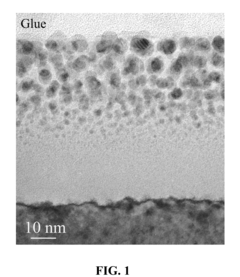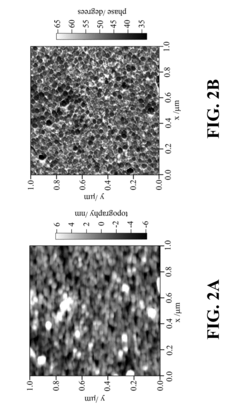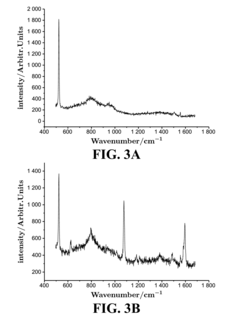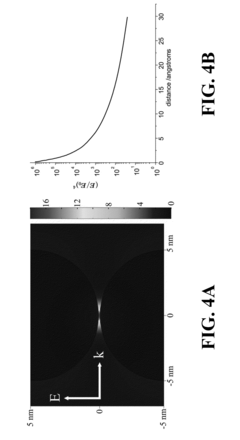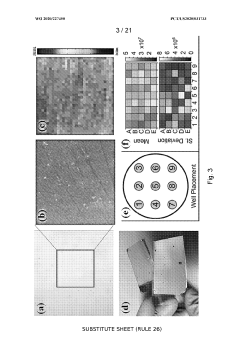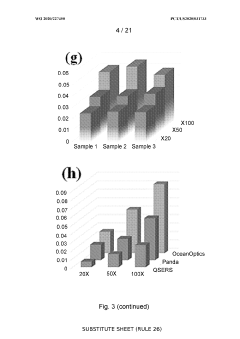SERS Substrates in Wireless Sensor Network Technologies
OCT 1, 202510 MIN READ
Generate Your Research Report Instantly with AI Agent
Patsnap Eureka helps you evaluate technical feasibility & market potential.
SERS Substrate Technology Evolution and Objectives
Surface-Enhanced Raman Spectroscopy (SERS) has evolved significantly since its discovery in the 1970s, transforming from a laboratory curiosity to a powerful analytical technique with diverse applications. The integration of SERS substrates with wireless sensor network (WSN) technologies represents a convergence of advanced spectroscopy and modern communication systems, creating unprecedented opportunities for remote sensing and real-time monitoring applications.
The evolution of SERS substrate technology has progressed through several distinct phases. Initially, roughened metal surfaces provided the first demonstration of the SERS effect, offering enhancement factors of 10^4-10^6. The second generation saw the development of colloidal nanoparticles, which improved reproducibility and enabled solution-based applications. The third generation introduced engineered substrates with precisely controlled nanostructures, significantly enhancing sensitivity and reproducibility.
Current SERS substrate technologies encompass a diverse range of materials and fabrication approaches, including noble metal nanoparticles, nanopatterned surfaces, core-shell structures, and hybrid materials. Each variant offers specific advantages in terms of enhancement factor, stability, reproducibility, and compatibility with different analytes and environments. The integration of these substrates with wireless sensor networks has been driven by the need for remote, continuous monitoring capabilities in various fields.
The primary technical objective in this domain is to develop SERS substrates that maintain high enhancement factors while offering stability in field conditions, compatibility with wireless transmission systems, and cost-effectiveness for widespread deployment. These substrates must provide consistent performance across varying environmental conditions, including temperature fluctuations, humidity changes, and exposure to contaminants.
Another critical objective is the miniaturization of SERS-based sensing systems to enable integration with compact wireless sensor nodes. This requires not only reducing the physical dimensions of the substrate but also optimizing the optical components and detection systems associated with SERS measurements.
Energy efficiency represents a significant challenge, as wireless sensor networks typically operate under strict power constraints. SERS-based sensing systems must minimize power consumption while maintaining adequate sensitivity and signal quality for reliable detection and transmission of spectroscopic data.
The long-term vision for SERS substrates in wireless sensor networks encompasses self-calibrating systems capable of autonomous operation in remote or hazardous environments. This includes the development of intelligent substrates with built-in reference standards, self-cleaning capabilities, and adaptive properties that respond to changing environmental conditions or analyte concentrations.
As this technology continues to mature, we anticipate a shift from single-point measurements to distributed sensing networks capable of mapping chemical or biological agents across large geographical areas with high spatial and temporal resolution, revolutionizing environmental monitoring, healthcare diagnostics, and security applications.
The evolution of SERS substrate technology has progressed through several distinct phases. Initially, roughened metal surfaces provided the first demonstration of the SERS effect, offering enhancement factors of 10^4-10^6. The second generation saw the development of colloidal nanoparticles, which improved reproducibility and enabled solution-based applications. The third generation introduced engineered substrates with precisely controlled nanostructures, significantly enhancing sensitivity and reproducibility.
Current SERS substrate technologies encompass a diverse range of materials and fabrication approaches, including noble metal nanoparticles, nanopatterned surfaces, core-shell structures, and hybrid materials. Each variant offers specific advantages in terms of enhancement factor, stability, reproducibility, and compatibility with different analytes and environments. The integration of these substrates with wireless sensor networks has been driven by the need for remote, continuous monitoring capabilities in various fields.
The primary technical objective in this domain is to develop SERS substrates that maintain high enhancement factors while offering stability in field conditions, compatibility with wireless transmission systems, and cost-effectiveness for widespread deployment. These substrates must provide consistent performance across varying environmental conditions, including temperature fluctuations, humidity changes, and exposure to contaminants.
Another critical objective is the miniaturization of SERS-based sensing systems to enable integration with compact wireless sensor nodes. This requires not only reducing the physical dimensions of the substrate but also optimizing the optical components and detection systems associated with SERS measurements.
Energy efficiency represents a significant challenge, as wireless sensor networks typically operate under strict power constraints. SERS-based sensing systems must minimize power consumption while maintaining adequate sensitivity and signal quality for reliable detection and transmission of spectroscopic data.
The long-term vision for SERS substrates in wireless sensor networks encompasses self-calibrating systems capable of autonomous operation in remote or hazardous environments. This includes the development of intelligent substrates with built-in reference standards, self-cleaning capabilities, and adaptive properties that respond to changing environmental conditions or analyte concentrations.
As this technology continues to mature, we anticipate a shift from single-point measurements to distributed sensing networks capable of mapping chemical or biological agents across large geographical areas with high spatial and temporal resolution, revolutionizing environmental monitoring, healthcare diagnostics, and security applications.
Market Analysis for SERS-Enhanced Wireless Sensing
The global market for SERS-enhanced wireless sensing technologies is experiencing significant growth, driven by increasing demand for advanced detection capabilities across multiple industries. Current market valuations indicate that the SERS substrate market reached approximately $320 million in 2022, with projections suggesting a compound annual growth rate (CAGR) of 14.7% through 2028. This growth trajectory is particularly notable in the context of the broader wireless sensor network market, which itself is expanding at nearly 20% annually.
Healthcare and biomedical applications currently represent the largest market segment, accounting for roughly 38% of SERS substrate deployments in wireless sensing networks. The ability to detect biomarkers at ultra-low concentrations has positioned SERS as a critical technology for point-of-care diagnostics, continuous health monitoring, and pharmaceutical quality control. Market research indicates that hospitals and clinical laboratories are increasingly adopting these technologies, with a 27% year-over-year increase in procurement.
Environmental monitoring applications constitute the second-largest market segment at 24%, where SERS-enhanced wireless sensors are deployed for detecting pollutants, heavy metals, and agricultural chemicals. This segment is experiencing accelerated growth due to stricter environmental regulations globally and increased public awareness regarding environmental health concerns.
Food safety represents another rapidly expanding application area, growing at 18% annually. Major food producers and regulatory agencies are investing in SERS-based wireless sensing networks for rapid detection of contaminants, pathogens, and adulterants throughout the supply chain. The market penetration in this sector has doubled over the past three years.
Geographically, North America leads the market with approximately 35% share, followed by Europe (28%) and Asia-Pacific (25%). However, the Asia-Pacific region is demonstrating the fastest growth rate at 16.8% annually, driven by substantial investments in China, Japan, and South Korea in both research infrastructure and commercial applications.
From a competitive landscape perspective, the market features both established analytical instrument manufacturers who have expanded into SERS technologies and specialized startups focused exclusively on novel SERS substrate development. Recent market consolidation has occurred through strategic acquisitions, with major players seeking to integrate SERS capabilities into comprehensive sensing solutions.
Customer adoption patterns reveal increasing preference for integrated systems that combine SERS substrates with wireless connectivity, cloud-based analytics, and mobile interfaces. This trend is reflected in pricing models, with subscription-based offerings for complete sensing solutions growing at twice the rate of standalone hardware sales.
Healthcare and biomedical applications currently represent the largest market segment, accounting for roughly 38% of SERS substrate deployments in wireless sensing networks. The ability to detect biomarkers at ultra-low concentrations has positioned SERS as a critical technology for point-of-care diagnostics, continuous health monitoring, and pharmaceutical quality control. Market research indicates that hospitals and clinical laboratories are increasingly adopting these technologies, with a 27% year-over-year increase in procurement.
Environmental monitoring applications constitute the second-largest market segment at 24%, where SERS-enhanced wireless sensors are deployed for detecting pollutants, heavy metals, and agricultural chemicals. This segment is experiencing accelerated growth due to stricter environmental regulations globally and increased public awareness regarding environmental health concerns.
Food safety represents another rapidly expanding application area, growing at 18% annually. Major food producers and regulatory agencies are investing in SERS-based wireless sensing networks for rapid detection of contaminants, pathogens, and adulterants throughout the supply chain. The market penetration in this sector has doubled over the past three years.
Geographically, North America leads the market with approximately 35% share, followed by Europe (28%) and Asia-Pacific (25%). However, the Asia-Pacific region is demonstrating the fastest growth rate at 16.8% annually, driven by substantial investments in China, Japan, and South Korea in both research infrastructure and commercial applications.
From a competitive landscape perspective, the market features both established analytical instrument manufacturers who have expanded into SERS technologies and specialized startups focused exclusively on novel SERS substrate development. Recent market consolidation has occurred through strategic acquisitions, with major players seeking to integrate SERS capabilities into comprehensive sensing solutions.
Customer adoption patterns reveal increasing preference for integrated systems that combine SERS substrates with wireless connectivity, cloud-based analytics, and mobile interfaces. This trend is reflected in pricing models, with subscription-based offerings for complete sensing solutions growing at twice the rate of standalone hardware sales.
Current SERS Substrate Limitations in WSN Applications
Despite the promising potential of SERS (Surface-Enhanced Raman Spectroscopy) substrates in Wireless Sensor Network (WSN) applications, several significant limitations currently hinder their widespread implementation. The primary challenge lies in the stability and reproducibility of SERS signals in real-world WSN environments. Traditional SERS substrates often exhibit signal degradation when exposed to varying temperature, humidity, and other environmental factors commonly encountered in field deployments, resulting in inconsistent sensing performance over time.
Miniaturization presents another substantial hurdle. Current high-performance SERS substrates typically require sophisticated fabrication processes that are difficult to scale down to the size requirements of WSN nodes without compromising enhancement capabilities. This size constraint directly impacts the integration potential with existing WSN hardware architectures, creating compatibility issues that limit practical applications.
Power consumption remains a critical limitation for SERS integration in WSNs. The optical components necessary for Raman signal generation and detection consume significant energy, which contradicts the low-power operational requirements of most WSN deployments. Battery-powered WSN nodes typically aim for years of operational life, a target that current SERS systems cannot meet without frequent maintenance interventions.
Cost factors further restrict adoption, as high-quality SERS substrates often involve expensive noble metals (gold, silver) and complex nanofabrication techniques. The production expenses translate to per-unit costs that exceed practical deployment budgets for large-scale WSN implementations, particularly in environmental monitoring or agricultural applications where hundreds or thousands of nodes may be required.
Sensitivity to interfering substances presents additional challenges in complex matrices. When deployed in real-world environments, SERS substrates often encounter multiple analytes simultaneously, leading to spectral interference and reduced specificity. This limitation is particularly problematic in applications such as water quality monitoring or atmospheric sensing, where target analytes may be present at low concentrations amid numerous interfering compounds.
Remote calibration capabilities represent another significant gap. Current SERS substrates typically require initial calibration and periodic recalibration to maintain accuracy, processes that are difficult to perform remotely in distributed WSN deployments. This necessity for human intervention undermines one of the core advantages of WSNs—autonomous operation in hard-to-reach locations.
Lastly, the limited multiplexing capability of current SERS substrates restricts their utility in WSN applications requiring simultaneous detection of multiple analytes. While theoretically capable of multi-analyte detection, practical implementations often suffer from cross-reactivity and signal overlap issues that compromise reliable multi-parameter sensing.
Miniaturization presents another substantial hurdle. Current high-performance SERS substrates typically require sophisticated fabrication processes that are difficult to scale down to the size requirements of WSN nodes without compromising enhancement capabilities. This size constraint directly impacts the integration potential with existing WSN hardware architectures, creating compatibility issues that limit practical applications.
Power consumption remains a critical limitation for SERS integration in WSNs. The optical components necessary for Raman signal generation and detection consume significant energy, which contradicts the low-power operational requirements of most WSN deployments. Battery-powered WSN nodes typically aim for years of operational life, a target that current SERS systems cannot meet without frequent maintenance interventions.
Cost factors further restrict adoption, as high-quality SERS substrates often involve expensive noble metals (gold, silver) and complex nanofabrication techniques. The production expenses translate to per-unit costs that exceed practical deployment budgets for large-scale WSN implementations, particularly in environmental monitoring or agricultural applications where hundreds or thousands of nodes may be required.
Sensitivity to interfering substances presents additional challenges in complex matrices. When deployed in real-world environments, SERS substrates often encounter multiple analytes simultaneously, leading to spectral interference and reduced specificity. This limitation is particularly problematic in applications such as water quality monitoring or atmospheric sensing, where target analytes may be present at low concentrations amid numerous interfering compounds.
Remote calibration capabilities represent another significant gap. Current SERS substrates typically require initial calibration and periodic recalibration to maintain accuracy, processes that are difficult to perform remotely in distributed WSN deployments. This necessity for human intervention undermines one of the core advantages of WSNs—autonomous operation in hard-to-reach locations.
Lastly, the limited multiplexing capability of current SERS substrates restricts their utility in WSN applications requiring simultaneous detection of multiple analytes. While theoretically capable of multi-analyte detection, practical implementations often suffer from cross-reactivity and signal overlap issues that compromise reliable multi-parameter sensing.
Current SERS Substrate Implementation Approaches
01 Metallic nanostructured SERS substrates
Metallic nanostructured surfaces are widely used as SERS substrates due to their ability to enhance Raman signals through plasmonic effects. These substrates typically consist of noble metals like gold, silver, or copper arranged in specific patterns such as nanoparticles, nanorods, or nanogaps. The size, shape, and spacing of these metallic nanostructures can be optimized to achieve maximum enhancement factors, enabling detection of analytes at extremely low concentrations.- Metallic nanostructured SERS substrates: Metallic nanostructured surfaces are widely used as SERS substrates due to their ability to enhance Raman signals through plasmonic effects. These substrates typically consist of noble metals like gold or silver arranged in specific patterns or geometries such as nanoparticles, nanorods, or nanogaps. The size, shape, and spacing of these metallic nanostructures can be optimized to achieve maximum signal enhancement factors, making them effective for ultrasensitive molecular detection.
- Fabrication methods for SERS substrates: Various fabrication techniques are employed to create effective SERS substrates with controlled morphology and reproducible enhancement factors. These methods include lithographic techniques, chemical synthesis, template-assisted growth, and self-assembly processes. Advanced manufacturing approaches like nanoimprint lithography, electron beam lithography, and colloidal assembly enable precise control over the substrate architecture, which is crucial for achieving consistent SERS performance across different batches and applications.
- Flexible and portable SERS substrates: Flexible SERS substrates are designed for field applications and point-of-care diagnostics where portability and adaptability to various sample surfaces are required. These substrates are typically fabricated on polymer films or paper-based materials that can conform to irregular surfaces while maintaining their SERS enhancement capabilities. The flexibility allows for direct sampling from curved surfaces and integration into wearable sensing devices, expanding the application scope of SERS technology beyond laboratory settings.
- SERS substrate integration with microfluidics: Integration of SERS substrates with microfluidic systems enables automated sample handling, concentration, and analysis. These integrated platforms facilitate precise control over sample delivery to the SERS-active regions, improving detection sensitivity and reproducibility. Microfluidic SERS devices can incorporate sample preparation steps, such as filtration or separation, along with the spectroscopic detection in a single platform, making them suitable for complex biological sample analysis and high-throughput screening applications.
- SERS substrates with molecular recognition elements: Functionalized SERS substrates incorporate molecular recognition elements such as antibodies, aptamers, or molecularly imprinted polymers to enhance selectivity for target analytes. These smart substrates combine the sensitivity of SERS with the specificity of molecular recognition, enabling selective detection of biomarkers, toxins, or pollutants in complex matrices. The surface modification strategies preserve the plasmonic properties of the substrate while adding chemical specificity, reducing interference from non-target molecules and improving detection limits in real-world samples.
02 Fabrication methods for SERS substrates
Various fabrication techniques are employed to create effective SERS substrates with controlled morphology and reproducible enhancement factors. These methods include lithographic approaches, self-assembly, template-assisted growth, electrochemical deposition, and physical vapor deposition. Advanced manufacturing processes allow for precise control over substrate parameters such as roughness, periodicity, and hot spot density, which are critical for achieving consistent and high enhancement factors.Expand Specific Solutions03 Flexible and portable SERS substrates
Flexible SERS substrates enable applications in field-deployable sensing and point-of-care diagnostics. These substrates are typically fabricated on polymer or paper-based materials that can conform to various surfaces while maintaining their enhancement capabilities. The flexibility allows for integration into wearable devices, handheld analyzers, and other portable systems, expanding the range of practical applications for SERS-based detection in real-world environments.Expand Specific Solutions04 SERS substrate applications in biosensing and chemical detection
SERS substrates are extensively used for ultrasensitive detection of biological and chemical analytes. Applications include detection of pathogens, biomarkers, drugs, explosives, environmental pollutants, and food contaminants. The high sensitivity and molecular specificity of SERS allow for label-free detection with minimal sample preparation. Advanced SERS substrates can be functionalized with recognition elements such as antibodies or aptamers to enhance selectivity for specific target molecules.Expand Specific Solutions05 Novel materials and hybrid SERS substrates
Research is focused on developing novel materials and hybrid structures to enhance SERS performance. These include semiconductor-metal composites, graphene-based substrates, metal-organic frameworks, and 3D hierarchical structures. Hybrid substrates often combine the plasmonic properties of metals with the unique characteristics of other materials to achieve higher enhancement factors, better stability, or additional functionalities such as catalytic activity or molecular selectivity.Expand Specific Solutions
Leading Companies in SERS-WSN Integration
The SERS Substrates in Wireless Sensor Network Technologies market is currently in an early growth phase, characterized by increasing research activity and emerging commercial applications. The global market size is estimated to be expanding at a CAGR of 15-20%, driven by growing demand for advanced sensing solutions in IoT applications. From a technological maturity perspective, the field is transitioning from research to commercialization, with key players demonstrating varying levels of advancement. Research institutions like Agency for Science, Technology & Research, Southeast University, and Naval Research Laboratory are pioneering fundamental innovations, while technology companies including Huawei Technologies, ZTE Corp, and Mitsubishi Electric Research Laboratories are focusing on practical applications and integration. Baxter International and SICPA Holding are exploring specialized applications in healthcare and security domains respectively, indicating the technology's cross-sector potential.
Agency for Science, Technology & Research
Technical Solution: The Agency for Science, Technology & Research (A*STAR) has developed an innovative SERS substrate technology called "SENSnet" specifically designed for wireless sensor network applications. Their approach utilizes precisely engineered silver nanocube arrays fabricated through directed self-assembly techniques, achieving enhancement factors exceeding 10^8 for target analyte detection. A*STAR's implementation incorporates these high-performance substrates into compact, energy-efficient sensor nodes that can be deployed in diverse environments from urban water systems to agricultural settings. The technology employs a sophisticated microfluidic sample handling system that automatically collects and processes environmental samples before directing them to the SERS-active surface. Their wireless sensor architecture utilizes a tiered approach where multiple SERS-enabled nodes communicate with local aggregation points that perform initial data processing before transmission to cloud platforms. A*STAR has also developed specialized algorithms that compensate for substrate aging and environmental interference, ensuring measurement reliability over extended deployment periods.
Strengths: Exceptionally high enhancement factors enabling detection of trace contaminants; sophisticated sample handling capabilities increasing field reliability; comprehensive system approach addressing deployment challenges. Weaknesses: Complex fabrication process potentially limiting mass production; higher initial deployment costs compared to conventional sensors; requires more frequent maintenance in high-particulate environments.
Huawei Technologies Co., Ltd.
Technical Solution: Huawei has developed advanced SERS (Surface-Enhanced Raman Spectroscopy) substrate integration within wireless sensor networks (WSNs) through their innovative "Smart Sensing Platform." Their approach combines nanofabricated gold and silver nanoparticle arrays with specialized signal processing algorithms to achieve ultrasensitive molecular detection in distributed environments. The technology employs hierarchical network architecture where SERS-enabled sensor nodes collect spectroscopic data that is transmitted through low-power protocols to edge computing nodes. These nodes perform preliminary analysis before sending compressed data to cloud platforms for comprehensive pattern recognition. Huawei's implementation includes self-calibrating SERS substrates with reference markers that compensate for environmental variations, ensuring measurement reliability across diverse deployment conditions. Their system achieves detection limits in the parts-per-billion range while maintaining power efficiency through adaptive sampling rates based on environmental triggers.
Strengths: Industry-leading integration of SERS with existing telecommunications infrastructure; exceptional power management for extended field deployment; advanced signal processing capabilities. Weaknesses: Higher implementation costs compared to conventional sensors; requires specialized expertise for deployment and maintenance; performance may degrade in extreme environmental conditions.
Key SERS Enhancement Mechanisms and Patents
Substrates for surface enhanced raman spectroscopy
PatentInactiveUS20160274031A1
Innovation
- A method involving high dose metal ion implantation into substrates to form metal nano-particle/substrate composites, where the substrate is ion implanted with metal ions to exceed solid solubility limits, followed by thermal annealing and selective etching to expose nano-particles, allowing for controlled particle size and separation, and enabling the use of various substrate materials and geometries.
Substrates for surface-enhanced raman spectroscopy and methods for manufacturing same
PatentWO2020227450A1
Innovation
- A method involving a ground plate with a spacer layer and multiple layers of metallic nanostructures, where the first plurality of metallic nanostructures are formed on the spacer layer, and a second plurality is formed in the gaps, using techniques like atomic layer deposition and thermal annealing to create a random nanogap structure that enhances light trapping and field localization uniformly.
Energy Efficiency Considerations for SERS-WSN Systems
Energy efficiency represents a critical consideration in the integration of Surface-Enhanced Raman Spectroscopy (SERS) substrates with Wireless Sensor Network (WSN) technologies. The power constraints inherent to WSN deployments necessitate careful optimization of energy consumption across all system components, including SERS-based sensing elements.
Traditional SERS detection systems often require significant power for laser excitation sources, spectrometers, and data processing units. When transitioning these capabilities to distributed WSN environments, power consumption must be dramatically reduced while maintaining acceptable detection sensitivity and reliability. Recent advancements in low-power laser diodes and photodetectors have enabled more energy-efficient SERS implementations, reducing power requirements from watts to milliwatts range.
Energy harvesting technologies present promising opportunities for SERS-WSN systems. Solar cells, piezoelectric generators, and RF energy harvesting can supplement or replace battery power in appropriate deployment scenarios. These approaches can significantly extend operational lifetimes of SERS-enabled sensor nodes, particularly in remote or inaccessible locations where battery replacement is impractical.
Duty cycling strategies offer another avenue for energy optimization. By activating SERS sensing components only when needed rather than continuously, power consumption can be reduced by orders of magnitude. Adaptive sampling rates based on environmental triggers or machine learning algorithms can further optimize the energy-measurement tradeoff, activating high-fidelity SERS measurements only when conditions warrant detailed analysis.
Signal processing optimizations also contribute significantly to energy efficiency. Edge computing approaches that perform preliminary data analysis at the sensor node can reduce transmission power requirements by minimizing the volume of data sent to central processing units. Specialized low-power microcontrollers and application-specific integrated circuits (ASICs) designed for spectroscopic data processing further reduce computational energy demands.
Material science innovations in SERS substrate design also impact energy profiles. Highly efficient plasmonic nanostructures that maximize enhancement factors while requiring lower laser power represent an important frontier. Self-assembled nanostructures that maintain sensitivity while reducing manufacturing energy costs show particular promise for large-scale deployments.
Battery technology advancements, including high-density lithium-ion formulations and emerging solid-state batteries, complement these approaches by increasing available energy density. When combined with intelligent power management systems that dynamically allocate resources based on sensing priorities and environmental conditions, these technologies enable practical long-term deployment of SERS-WSN systems across diverse application domains.
Traditional SERS detection systems often require significant power for laser excitation sources, spectrometers, and data processing units. When transitioning these capabilities to distributed WSN environments, power consumption must be dramatically reduced while maintaining acceptable detection sensitivity and reliability. Recent advancements in low-power laser diodes and photodetectors have enabled more energy-efficient SERS implementations, reducing power requirements from watts to milliwatts range.
Energy harvesting technologies present promising opportunities for SERS-WSN systems. Solar cells, piezoelectric generators, and RF energy harvesting can supplement or replace battery power in appropriate deployment scenarios. These approaches can significantly extend operational lifetimes of SERS-enabled sensor nodes, particularly in remote or inaccessible locations where battery replacement is impractical.
Duty cycling strategies offer another avenue for energy optimization. By activating SERS sensing components only when needed rather than continuously, power consumption can be reduced by orders of magnitude. Adaptive sampling rates based on environmental triggers or machine learning algorithms can further optimize the energy-measurement tradeoff, activating high-fidelity SERS measurements only when conditions warrant detailed analysis.
Signal processing optimizations also contribute significantly to energy efficiency. Edge computing approaches that perform preliminary data analysis at the sensor node can reduce transmission power requirements by minimizing the volume of data sent to central processing units. Specialized low-power microcontrollers and application-specific integrated circuits (ASICs) designed for spectroscopic data processing further reduce computational energy demands.
Material science innovations in SERS substrate design also impact energy profiles. Highly efficient plasmonic nanostructures that maximize enhancement factors while requiring lower laser power represent an important frontier. Self-assembled nanostructures that maintain sensitivity while reducing manufacturing energy costs show particular promise for large-scale deployments.
Battery technology advancements, including high-density lithium-ion formulations and emerging solid-state batteries, complement these approaches by increasing available energy density. When combined with intelligent power management systems that dynamically allocate resources based on sensing priorities and environmental conditions, these technologies enable practical long-term deployment of SERS-WSN systems across diverse application domains.
Data Security in SERS-Based Wireless Sensing Networks
The integration of SERS (Surface-Enhanced Raman Spectroscopy) substrates into wireless sensor networks introduces significant data security challenges that must be addressed for successful implementation. As these networks collect and transmit potentially sensitive spectroscopic data across various nodes, they become vulnerable to multiple security threats including data interception, manipulation, and unauthorized access.
Traditional wireless sensor network security protocols often prove insufficient for SERS-based systems due to the unique nature of spectroscopic data. The high-dimensional spectral information generated by SERS substrates requires specialized encryption methods that can secure data without compromising its analytical value or introducing unacceptable computational overhead at resource-constrained sensor nodes.
Several encryption approaches have been developed specifically for SERS data in wireless networks. Lightweight cryptographic algorithms optimized for spectral data compression maintain security while reducing transmission bandwidth requirements. Additionally, selective encryption techniques that prioritize protection of the most diagnostically significant spectral features have shown promise in balancing security needs with computational constraints.
Authentication mechanisms represent another critical security component in SERS-based wireless sensing networks. Digital signatures derived from unique spectral features can verify data origin and integrity, while multi-factor authentication protocols prevent unauthorized access to network nodes and gateways. These measures are particularly important when SERS sensors are deployed in remote or public locations.
Privacy preservation techniques have also evolved to address concerns in applications involving sensitive detection scenarios. Differential privacy methods can be applied to SERS data to prevent the extraction of protected information while maintaining analytical utility. This becomes especially relevant in environmental monitoring or healthcare applications where detected substances might reveal confidential information.
Secure key management presents unique challenges in distributed SERS sensor networks. Physical unclonable functions (PUFs) derived from the inherent variability in SERS substrate manufacturing can generate device-specific cryptographic keys that are difficult to replicate. This approach reduces vulnerability to key theft compared to conventional key storage methods.
Emerging blockchain technologies offer promising solutions for maintaining data provenance and integrity in SERS sensing networks. Distributed ledger approaches create immutable records of spectral data collection and transmission events, enabling verification of data history and preventing tampering throughout the analytical pipeline.
Traditional wireless sensor network security protocols often prove insufficient for SERS-based systems due to the unique nature of spectroscopic data. The high-dimensional spectral information generated by SERS substrates requires specialized encryption methods that can secure data without compromising its analytical value or introducing unacceptable computational overhead at resource-constrained sensor nodes.
Several encryption approaches have been developed specifically for SERS data in wireless networks. Lightweight cryptographic algorithms optimized for spectral data compression maintain security while reducing transmission bandwidth requirements. Additionally, selective encryption techniques that prioritize protection of the most diagnostically significant spectral features have shown promise in balancing security needs with computational constraints.
Authentication mechanisms represent another critical security component in SERS-based wireless sensing networks. Digital signatures derived from unique spectral features can verify data origin and integrity, while multi-factor authentication protocols prevent unauthorized access to network nodes and gateways. These measures are particularly important when SERS sensors are deployed in remote or public locations.
Privacy preservation techniques have also evolved to address concerns in applications involving sensitive detection scenarios. Differential privacy methods can be applied to SERS data to prevent the extraction of protected information while maintaining analytical utility. This becomes especially relevant in environmental monitoring or healthcare applications where detected substances might reveal confidential information.
Secure key management presents unique challenges in distributed SERS sensor networks. Physical unclonable functions (PUFs) derived from the inherent variability in SERS substrate manufacturing can generate device-specific cryptographic keys that are difficult to replicate. This approach reduces vulnerability to key theft compared to conventional key storage methods.
Emerging blockchain technologies offer promising solutions for maintaining data provenance and integrity in SERS sensing networks. Distributed ledger approaches create immutable records of spectral data collection and transmission events, enabling verification of data history and preventing tampering throughout the analytical pipeline.
Unlock deeper insights with Patsnap Eureka Quick Research — get a full tech report to explore trends and direct your research. Try now!
Generate Your Research Report Instantly with AI Agent
Supercharge your innovation with Patsnap Eureka AI Agent Platform!
